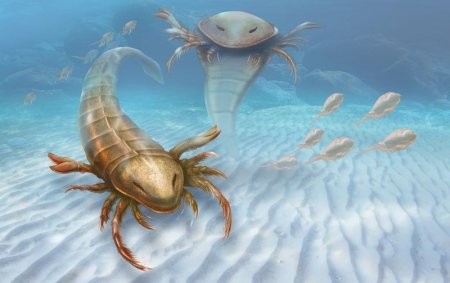More than four million centuries ago, the Earth's waters were inhabited by 6 feet long sea scorpions. With their giant Reuleaux triangular head, the creatures resembled ancient Greek warships.
Pentecopterus was one of the earliest gigantic predators. The creature was named after the Penteconter, a galley used by the ancient Greeks. While Penteconter had more than a dozen paddles according to Britannica, the Pentecopeterus had more than a dozen legs. Both have long bodies.
Colossal fossils of the intimidating sea monster were discovered in Northeastern Iowa on Sept. 1. Pentecopterus Decorahensis lived 467 million years ago during the Ordovician Period.
"Pentecopterus was an incredibly bizarre animal, with a long head that looked somewhat like the prow of a ship, a narrow body, and massively enlarged limbs that it used to capture prey," Yale University paleontologist James Lamsdell said.
"It would have grabbed prey with its large, spiny legs and then pulled it towards its mouth," Lamsdell added.
Exceptionally found in a good condition, the fine details of an adult's and an infant's exoskeleton can be appreciated, Yahoo News reported.
"You would not want one of these in your swimming pool," said Yale paleontologist Derek Briggs.
Pentecopterus is the earliest-known member of Eurypterids, an extinct arthropod group that was highly significant in the marine ecosystem of their time. Ranging from small scavengers to large apex predators, they are closely related to modern horseshoe crabs and terrestrial arachnids spiders and scorpions.
The largest-known Eurypterids exceeded 8 feet long. Eurypterids flourished until about 360 million years ago when their numbers dwindled drastically. They were extinct approximately 254 million years ago.
The researchers are looking forward to discovering older sea scorpions. Prior to the discovery of Pentecopterus, Brachyopterus is the oldest known member of the group. Pentecopterus is 10 million years older than the small, primitive Eurypterid.
The Pentecopterus remains were found in an ancient meteorite impact crater more than 3 miles in diameter by the Upper Iowa River and were excavated after the river was dammed temporarily.
The research, authored by Lamsdell, Brigg, Huaibao P. Liu, Brian J. Witzke, and Robert M. McKay, was published in the journal BMC Evolutionary Biology.



























